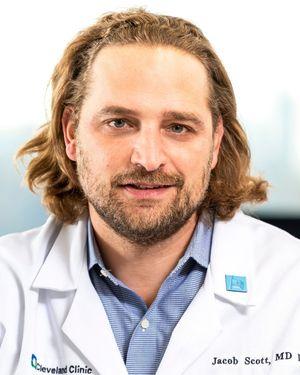Research News
08/24/2020
Adapting Ideas from Quantum Physics to Calculate Alternative Interventions for Infection and Cancer
A team co-led by Dr. Scott shows for the first time how ideas from quantum physics can be translated and applied to biological problems, laying the foundation for a potential new area of study entirely, called quantum-inspired biological control.

Published in Nature Physics, findings from a new study co-led by Cleveland Clinic and Case Western Reserve University teams show for the first time how ideas from quantum physics can help develop novel drug interventions for bacterial infections and cancer.
The research team demonstrated that principles of quantum control, a field of quantum physics used in computing applications, can be translated and applied to biological problems. They constructed a mathematical algorithm that can be used to design and speed-up specific interventions to prevent or overturn drug resistance.
Typically cells in the presence of drugs evolve according to Darwinian natural selection: mutants that are resistant to the drug can outcompete their susceptible neighbors, dominating the population. Counterintuitively, one can also co-opt this process to achieve the opposite result, ultimately defeating drug resistance. For example, a mutation that causes resistance to one drug may cause extreme susceptibility to another, a phenomenon known as collateral sensitivity.
“If that mutant is initially only a small fraction of the population, we can use the first drug to encourage its dominance, and then apply the second drug to rapidly wipe out the infection,” said physician-scientist Jacob Scott, MD, DPhil, a practicing radiation oncologist at Cleveland Clinic and co-senior author on the study, referencing findings from a study his group published earlier this year. “But we also know that the first stage can be slow: mutations occur at random times, and waiting long enough until the mutant fully takes over could compromise treatment effectiveness and patient outcomes. The time it takes to ensure these interventions are successful has been a significant limitation to adopting evolutionary medicine into clinical practice.”
Speeding up this process is where quantum physics can provide inspiration. “The randomness of mutations in evolution has intriguing mathematical parallels to the randomness of quantum phenomena, according to Professor Michael Hinczewski, a theoretical biophysicist at Case Western Reserve University and co-senior author. “This randomness makes it challenging to reliably and quickly drive a quantum system from one state to another. Solving this driving problem is an essential ingredient in certain types of quantum computing. Our new study exploits these parallels, translating a particular quantum technique known as counterdiabatic driving into the language of evolutionary biology.”
“Imagine trying to get a system to follow a desired path from an initial state over a short time, whether this path is a sequence of quantum states or varying proportions of mutants in an evolving population,” said Professor Hinczewski. “Counterdiabatic driving is a form of dynamic correction, providing just enough external intervention to keep the system on path at every instant no matter how fast the protocol.”
The researchers created a mathematical algorithm to calculate this intervention in evolutionary medicine applications. The algorithm’s output is a prescription for dynamically altering the drug dosages or types to stay on the target path. The team demonstrated their technique by using it to manipulate evolution in simulations of living cells. These simulations were based on experimental data from an earlier study on a set of mutants showing varying degrees of resistance to anti-malarial drugs.
Counterdiabatic driving changed the proportion of mutants, affecting the population’s overall drug sensitivity, faster and with better control than could be expected using current experimental methods in evolutionary medicine.
Given the team’s promising findings, the next phase of their research will be to conduct direct experimental testing of the approach. As the first example of counterdiabatic driving in a biological context, the researchers are hopeful that their work could provide a foundation for a novel area of study: quantum-inspired biological control. The researchers plan to apply these ideas to other biological systems that share similarities with evolution, such as stem cell development and ecology.
In addition to Drs. Hinczewski and Scott, the work was led by co-first authors Shamreen Iram, Emily Dolson, PhD, and Joshua Chiel, part of a collaboration that included Professor Sebastian Deffner, of the University of Maryland, Baltimore County, and Efe Ilker, PhD, of the Institut Curie in Paris.
The project was supported in part by the National Cancer Institute, part of the National Institutes of Health, and the National Science Foundation.
Featured Experts
News Category
Related News
Research areas
Want To Support Ground-Breaking Research at Cleveland Clinic?
Discover how you can help Cleveland Clinic save lives and continue to lead the transformation of healthcare.
Give to Cleveland Clinic